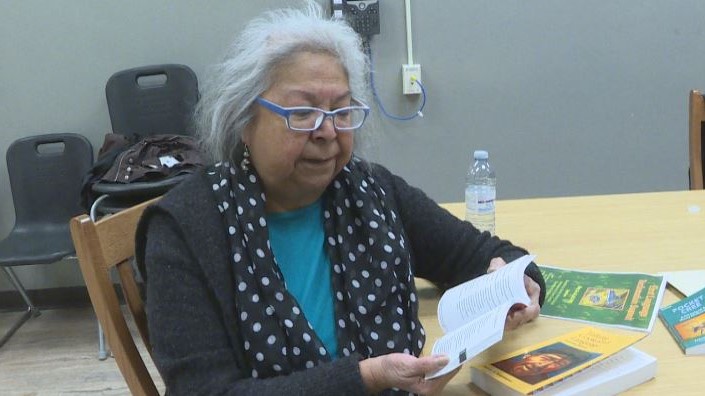Pat Ningewance, an assistant professor at the University of Manitoba, has been teaching her language, Ojibwe, for 40 years. But for her students, it’s not easy to learn.

“There’s always a block there for them,” she says. “The non-native students in my classroom, they don’t seem to have that problem. They can pronounce the words — to them, it’s a subject, you know, they don’t have any emotional baggage.”
That “block” was the subject of a recent summit at the university, where speakers from multiple nations came together to discuss the difficulty of both learning and teaching their languages. Ningewance says generations of inherited trauma or shame, caused by racism and residential schools, make it difficult for Indigenous learners to get the words out.
She also says it’s not enough just to teach language and writing in a classroom.
“You teach the grammar. You teach conversation, but mostly grammar and writing. And that’s not producing any speakers. It isn’t.”
Because of that, Ningewance says she’s been changing her methods to include more language immersion. She writes scripts for her students about everyday situations, like being in a restaurant, and has them speak about things that would take place in their day-to-day lives.
Heather Souter teaches Michif, a Métis language, and is also a director of the Prairies to Woodlands Indigenous Language Revitalization Circle. She agrees that language learning needs to be integrated into spaces outside the classroom.
“Language really needs to be learned in context,” she says. “So having a language house where people can learn together in a family setting, but also go out onto the land, or into the community.”
Unlike people who learn French or German, for example, Michif learners don’t have a place they can go to be immersed in the language.
“We have to create these somewhat artificial environments to support us,” Souter says.
As of 2021, Statistics Canada reported that Ojibwe had 25,440 speakers. Michif had 1,845. UNESCO classifies Michif as “critically endangered.”
But there is some good news: the number of Michif speakers has increased by 57 per cent since 2016. Since just a handful of native speakers remain, the majority of those speakers learned Michif as a second language, indicating language revitalization is taking place.
Ningewance also believes attitudes toward Indigenous languages are changing.
“I think now, the young people are realizing how important it is to learn their language,” Ningewance says. “I do hear that a lot in my classes here.”
Ningewance hopes that momentum continues, but not just in academia.
“While we still have fluent speakers, we need to make movies,” she says. “Not just translate them, not just dub them.”
And not only movies, but also books, radio, music, and even advertisements, to make people aware of the value of these languages.
Long term, she hopes to see entire communities take up these languages, where everything from schools to hospitals use them exclusively.
“I envision the language being spoken in pockets where we create these small towns, where only the language is spoken, no English at all, people choose to live there.”
In the meantime, experts say revitalization efforts need to continue and expand. Souter says invaluable work is being done in Brandon, where elders and learners take part in a mentor-apprentice program. Together, they learn and document conversational Michif, encompassing activities out on the land as well. Prairies to Woodlands Indigenous Language Revitalization Circle also compiles digital resources and recordings at michif.org and southernmichif.org.
But she says both educators and policymakers need to keep in mind that each language requires a different approach.
“You can have people doing documentation and transcription, which we need to do for all of our languages,” Souter says. “But some languages, like ours, maybe need to focus more on creating new adult speakers to embody the language and embody the social and cultural practices.”








Comments